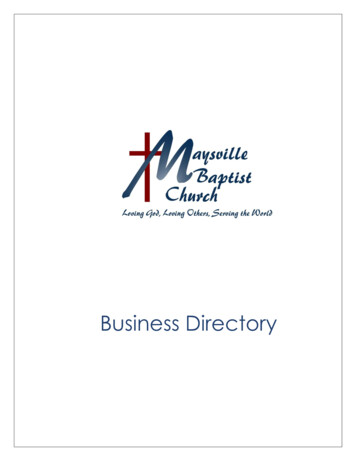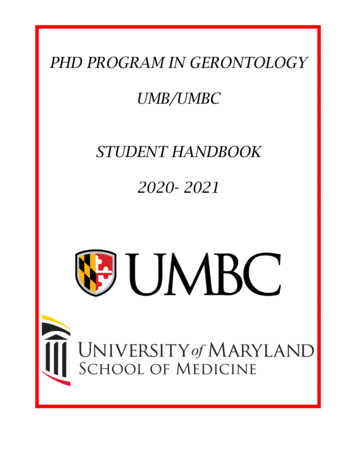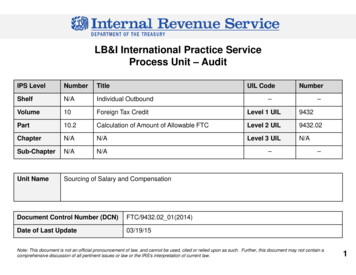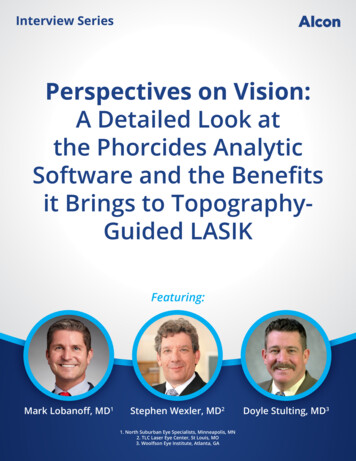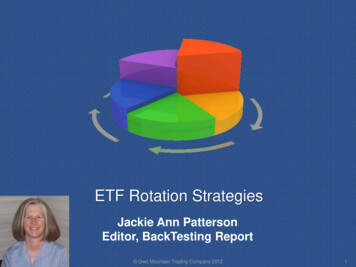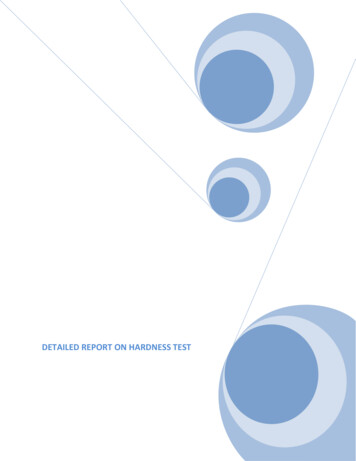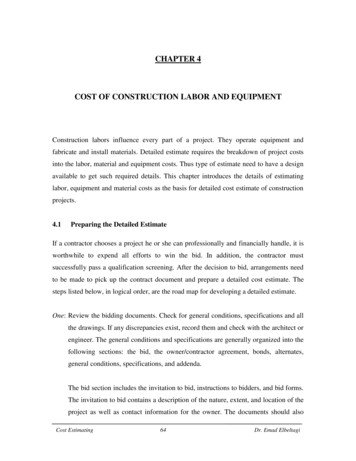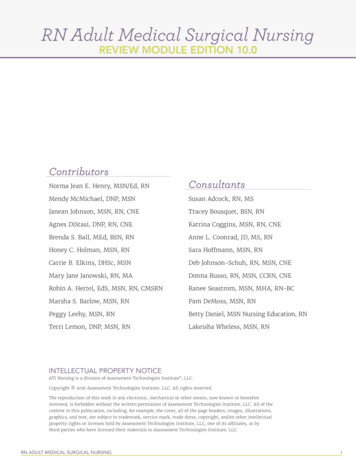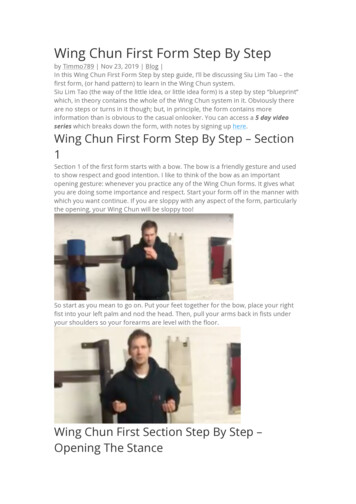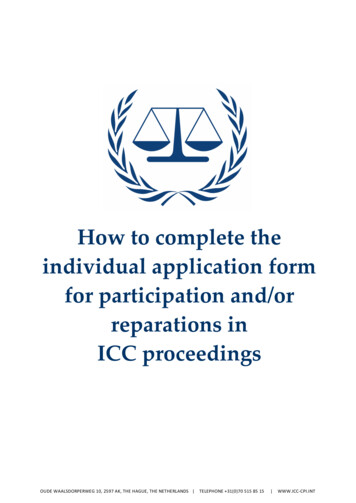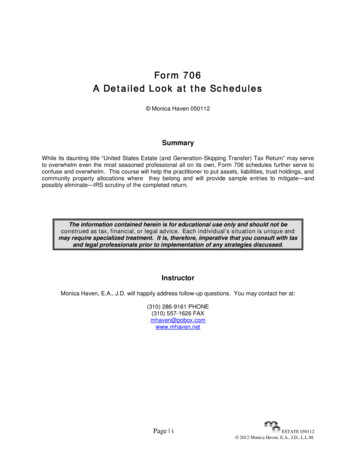
Transcription
Fo r m 7 0 6A De t a i l e d L o o k a t t h e Sc h e d u l e s Monica Haven 050112SummaryWhile its daunting title “United States Estate (and Generation-Skipping Transfer) Tax Return” may serveto overwhelm even the most seasoned professional all on its own, Form 706 schedules further serve toconfuse and overwhelm. This course will help the practitioner to put assets, liabilities, trust holdings, andcommunity property allocations where they belong and will provide sample entries to mitigate—andpossibly eliminate—IRS scrutiny of the completed return.The information contained herein is for educational use only and should not beconstrued as tax, financial, or legal advice. Each individual’s situation is unique andmay require specialized treatment. It is, therefore, imperative that you consult with taxand legal professionals prior to implementation of any strategies discussed.InstructorMonica Haven, E.A., J.D. will happily address follow-up questions. You may contact her at:(310) 286-9161 PHONE(310) 557-1626 FAXmhaven@pobox.comwww.mhaven.netPage iESTATE 050112 2012 Monica Haven, E.A., J.D., L.L.M.
Table of ContentsI.Introduction . 1II.Form 706 . 1Due Date and ExtensionLiability for the TaxStatute of LimitationsPenaltiesIII.The Gross Estate . 4Tax RateApplicable Exclusion (Unified Credit)Sample Tax CalculationIV.Estate Assets . 7Alternate Valuation DateExempt AssetsIncome in Respect of DecedentValuations and AppraisalsV.A Look at the Schedules . 12Schedule A – Real EstateSchedule B – Stocks & BondsSchedule C – Mortgages, Notes & CashSchedule D – Life InsuranceSchedule E – Jointly Owned PropertySchedule F – Miscellaneous PropertySchedule G – Lifetime TransfersSchedule H – Powers of AppointmentSchedule I – AnnuitiesSchedule J – Funeral & Administrative ExpensesSchedule K – Decedent’s DebtsSchedule L – Loses during AdministrationSchedule M – Spousal BequestsSchedule O – Charitable BequestsVI.Stepped-up Basis . 23Joint AssetsCommunity Property2010 – The ExceptionVII.Audit Prevention . 25Attachments“Top Ten” Audit TriggersMake it Look GoodPage iiESTATE 050112 2012 Monica Haven, E.A., J.D., L.L.M.
I.IntroductionBy definition, the whole of property owned by anyone, including both real and personalproperty, is deemed to be that person’s estate.1 Upon death, this estate will bedistributed in accordance with the terms of the decedent’s will (trust) or, if there is no will,by the laws of intestacy applicable in the state of the decedent’s domicile.Depending on the size of the decedent’s estate, Form 706, United States Estate (andGeneration-Skipping Transfer) Tax Return [Form 706] may be required.2 Although areturn is in fact only required if the decedent’s estate (valued on the date of death[DOD]) plus taxable lifetime gifts exceeds the applicable exclusion amount for the year ofdeath, the fiduciary may nevertheless opt to file:To obtain a closing letter from the IRS, definitively putting all estate tax matters permanentlyto rest, orTo establish cost basis for the surviving heirs, stepped-up to the valuations at the DOD asreported on the return, orTo preclude claims by disgruntled heirs based on accepted asset valuations.In this text, I will begin by taking a look at the filing requirements in general and thenproceed to examine the schedules and components of the estate tax return in detail. Iwill attempt to explain the rationale and legislative intent of applicable code sections andprovide preparer tips to ensure that the return you ultimately file can survive IRSscrutiny.II.Form 706A.Due Date and ExtensionForm 706 is due nine months after the DOD3 or April 15th of the calendar yearfollowing the date of distribution from a Qualified Domestic Trust.4Qualified Domestic Trust (QDOT)U.S. tax law imposes restrictions on transfers to non-U.S. citizens for fear of losingjurisdiction and the ability to tax dollars that have left the country. As a result, the marital5deduction for the transfer of property directly to a non-citizen spouse is disallowed andpermitted only if the estate of a citizen spouse is transferred to the non-citizen spouse in6trust under the following conditions:1IRC § 2033.2The estate tax is an asset-based tax, not an income tax.3IRC § 6075(a).4IRC § 2056A(b)(5).5IRC § 2056(d)(1).6IRC § 2056(d)(2).Page 1ESTATE 050112 2012 Monica Haven, E.A., J.D., L.L.M.
-All trustees must be individual U.S. citizens or, if trust assets exceed 2 million, thetrustee must be a domestic bank;The surviving spouse must receive all of the trust’s income, paid at least annually;The trust must pay the requisite tax on any income other than what is distributedannually to the surviving spouse as well as the tax due upon the death of thesurviving spouse; andAn irrevocable election to treat the trust as a QDOT must be made on the decedent'sestate tax return.Separate returns are required for husband and wife even if death occurs (near-)simultaneously in the same calendar year, since Form 706 may be used to reportthe estate of only one decedent and each spouse has his own lifetime exclusion.Form 4768 Application for Extension of Time to File a Return and/or PayU.S. Estate (and Generation-Skipping Transfer) Taxes may be used toautomatically extend the filing (but not payment)7 deadline by six months.No estimated tax is due; the tax liability must be paid in full with the filing of thereturn or the extension request. However, extensions for payments areavailable:For up to ten years for reasonable cause,8 although interest on the unpaidbalance will continue to accrue9For up to five years if more than 35% of the decedent’s wealth is tied up in aclosely-held business or farm10 – the tax must then be paid in ten equalannual installments.Interest accrued on an estate tax liability deferred for hardship reasons isdeemed to be personal interest not deductible on the fiduciary income taxreturn,11 although it may be claimed on the estate tax return as an administrationexpense [Schedule L].B.Liability for the TaxThe personal representative of the decedent’s estate is personallyliable for the estate tax due, as well as any unpaid income, giftand generation-skipping taxes. He may request release frompersonal liability from the estate tax as early as nine months afterthe estate tax return is due (or filed, if later) by submitting a written application tothe IRS and paying all outstanding balances or posting a bond if the payment7Reg. 20.6151-1.8IRC § 6161(a)(2).9A Late Filing Penalty of 5% of tax per month (up to 25%) may be assessed in addition to a Late Payment Penalty, as well asinterest on any unpaid balance due.10IRC § 6166.11IRS Chief Council Advice 200836027.Page 2ESTATE 050112 2012 Monica Haven, E.A., J.D., L.L.M.
period was extended.12 He may also file Form 5495 Request for Dischargefrom Personal Liability under Internal Revenue Code Section 2204 or 6905to request early discharge from personal liability for a decedent’s income and gifttaxes.13In certain circumstances, a decedent’s heir may become liable for the unpaidtaxes of a decedent.14C.Statute of LimitationsAs with all returns, the IRS has three years in which to audit an estate tax return;however, the estate’s representative may file Form 4810 Request for PromptAssessment under Internal Revenue Code Section 6501(d) to shorten thestatute of limitations to eighteen months. Instructions for the form specificallystate that it may not be filed until all returns listed on the request have alreadybeen filed. The practitioner should advise the fiduciary that this request willalmost assuredly invite scrutiny of the tax return by IRS examiners and so therequest should be made only upon due consideration.D.PenaltiesTaxpayers may be subject to penalties ranging from late filing and late paymentassessments15 to penalties arising from valuation misstatements for which theywill be assessed 20% of any underpayment caused by a substantial over- orunderstatement of value.16Persons – including lawyers, appraisers, and tax practitioners – who knowinglyaid and abet the understatement of another’s tax liability may also bepenalized.17 In 2007, preparer penalties for understatement of a taxpayer’sincome tax liability were extended to include preparers of estate and gift taxreturns.1812IRC § 2204.13IRC § 6905(a).14IRC § 6901(c)(1).15IRC §§ 6651(a)(1) and (2).16IRC 6662 defines “ substantial” misstatements as those that are 65% or less of the determined value and cause a taxunderstatement of more than 5,000. The penalty is increased to 40% for “ gross” valuation misstatements which are 40% or lessof the determined value.17IRC § 6701.18IRC § 6694.Page 3ESTATE 050112 2012 Monica Haven, E.A., J.D., L.L.M.
ESTATE TAXForm 706 is due nine months after DOD but the filing deadline can be extended anadditional six months with Form 4768.The tax liability must generally be paid nine months after DOD.The personal representative of the estate may apply to be released from personalliability for the estate, gift and income taxes of the decedent.The IRS may audit an estate tax returns for up to three years after filing, but the statutemay be shortened to 18 months by filing Form 4810.Various penalties may be assessed against both the personal representative and thepreparer of the return.III.The Gross Estate19A decedent’s gross estate includes his worldly possessions; in other words, the total ofall of his property owned—wherever situated—on the DOD. This includes (a) cash,investments, retirement assets, tax-exempt assets, business assets, real and personalproperty; (b) probate, as well as jointly-held assets; (c) non-taxable assets exempt fromtaxation under the marital or charitable deductions; (d) life insurance and annuities, aswell as special interests and powers;20 and (e) one-half of the decedent’s communityproperty.Under certain circumstances, additional assets may be added back to the gross estatethat had been previously transferred and would appear to no longer have been in thedecedent’s possession on the DOD. When an individual retains the right to revoke atransfer to a trust until his death, or disposes of that right within three years of death, thetrust assets in that trust will be includible in his gross estate [Schedule G].21 On theother hand, gifts from a grantor trust will be treated as though they were made by thedecedent himself, are eligible for the annual gift tax exclusion, and not includible in theestate.22The Estate Tax CalculationThe estate tax liability is computed based on the Gross Estate[GE] less applicable Deductions [D]23 which results in the TaxableEstate [TE]. The Tax Base [TB], then, requires that AdjustableTaxable Gifts [ATG] are added back to the Taxable Estate.2419Computed on Form 706, Page 3, Line 10 and carried to Page 1, Line 1 for tax computation.20IRC § 2505.21IRC § 2038.22IRC § 2035(e).23IRC § 2051.24IRC § 2001(b)(1).Page 4ESTATE 050112 2012 Monica Haven, E.A., J.D., L.L.M.
In short, the formulas used to calculate the estate tax liability is:TE GE – DTB TE ATGDeductionsState Death Taxes – prior to 2005, federal law allowed for a credit against the federalliability for estate taxes paid to state taxing authorities, but the credit was replaced with adeduction [Form 706, Page 1, Line 3b].25 States that previously calculated their taxliability by charging an amount equal to the maximum federal credit (now no longerinexistence) were required to change their tax structure or lose estate tax revenues. 26Other Expenses – to be deductible, expenses must be reasonable and necessary bothunder federal and state law.27 For example, the interest expense incurred by a trustee tomaintain, rather than sell a trust asset for seven years was disallowed because theexpenditure was incurred for the benefit of the heirs and not the estate.28Specifically, commissions and fees may be deducted if actually paid or reasonablyestimated. The expense of selling estate assets is deductible if it is necessary to pay theestate’s obligations. The cost of recourse debt is deductible, although assets secured bynon-recourse debt are reported on Form 706 net of the liability and so that mortgagepayment is not deductible. Deductions may be taken for services (i.e. caretaking)provided to the decedent at the full value of the consideration bargained for—even if thatamount exceeds what would otherwise be considered fair market value [FMV].Tax RateThe maximum effective rate in 2012 is 35%.29 This is the lowest rate in 70 years!Unless existing law is extended or new legislation is adopted before 2013, the tax ratewill revert to 55% as per pre-2001 rules.Applicable Exclusion (Unified Credit)Once the tax rate is applied to the tax base and the tentative tax liability is calculated, anexclusion may be applied to reduce the tax liability ultimately due.25IRC § 2058.26A detailed and updated listing of applicable state laws is available at 6.asp?SearchFor state%20death [last accessed May 1, 2012].27Reg. § 20.2053-3a.28Hibernia Bank, 581 F2d 741 (1978).29IRC § 2001(c) provides the current graduated rate schedule.Page 5ESTATE 050112 2012 Monica Haven, E.A., J.D., L.L.M.
The applicable gift and estate tax exclusion amount in 2011 was 5 million ( 10 millionfor husband and wife). Indexed for inflation after 2011, the exclusion currently in 2012 is 5.12 million per individual.30 If current law is not extended, the exclusions will revert toa mere 1 million. Taxpayers now complacent in the knowledge that they are unaffectedby the estate tax may awaken to an unpleasant surprise on January 1, 2013!Effective January 1, 2011, the exclusion for married couples has been treated as acollective exemption which means that any portion of the exclusion which was not usedby the first spouse to die transfers to the surviving spouse.31 However, this provision isalso scheduled to expire and if portability of the exclusion between husband and wife isnot renewed after 2012, the surviving spouse will have to forego the inherited exclusionfrom the spouse who died in 2011 or 2012.The lifetime exclusion is applicable to both gift and estate taxes and, in fact, has beenunified under the Tax Reform Act of 1976 and renamed the “Applicable Credit Amount”.While the effect is the same, the exclusion is used to reduce the amount of taxableestate; whereas the credit is used to reduce the amount of tax due. Therefore, whenproperly computing the estate tax liability on Form 706, the taxpayer begins by reportingcalculating the tax on the full value of the taxable estate. Only after the tax is calculated,may the taxpayer then subtract the applicable credit to determine the actual tax due.Sample Calculation32Decedent made 1.5M taxable gifts between 2002 and 2005. His gross estate is valuedat 6 million when he died in early 2011 and he has no allowable deductions. 555,800– 345,800 210,000 6M 0 6M 1.5M 7.5M 2,605,800– 1,730,800 875,000 210,000 665,000Gift tax liability on previously-made 1.5 million taxable giftsLifetime credit allowed on 1 million of gifts(based on credit available during tax years 2002 – 2005)Gift tax previously paid during lifetimeGross EstateDeductionsTaxable EstatePreviously-made taxable giftsTax BaseTentative estate tax liabilityApplicable Credit (based on 5M in 2011)Tentative TaxGift tax previously paid [see above]Estate tax due30This exclusion translates to an estate tax credit of 1,772,800 (based on current applicable tax rates).31Tax Relief Act of 2010, § 303(a).32Computed on Form 706, Page 1, Lines 1 – 20.Page 6ESTATE 050112 2012 Monica Haven, E.A., J.D., L.L.M.
THE GROSS ESTATEThe estate tax is assessed against the gross estate net of allowable deductions.Gifts made by the decedent during life are added back to the taxable estate; a credit forpreviously-paid gift taxes may be applied against the resulting estate tax.The maximum tax rate (in 2012) is 35% but will automatically revert to 55% if currentlegislation is not extended by year-end.Each decedent is entitled to a Unified Credit ( 1,772,800 in 2012) which, if notpreviously reduced or used in its entirety by lifetime gifts, may now be used to reducethe computed estate tax liability.IV.Estate AssetsInformation entered and totaled on each separate schedule of Form 706 is carried overto Page 3, Part 5 and recapitulated there. Two columns provide for the opportunity to listvalues of the decedent’s assets on the DOD as well as on the Alternate Valuation Date[AVD].A.Alternate Valuation DateThe general rule for Form 706 reporting requires the decedent’s property to bevalued on the DOD,33 but the estate’s representative may instead make anirrevocable election to report values on the AVD, up to six months later.34 If anasset was disposed of or transferred to the estate’s beneficiary prior to the sixmonth valuation date, AVD valuation of that asset is determined on the date ofdisposition or transfer. The AVD may only be used if it serves to decrease thevalue of the gross estate, as well as the attendant Estate and GenerationSkipping Tax liability.35If Form 706 is not filed or no estate tax is due, the AVD may not be elected. Normay the AVD be used to step-up the basis of assets that have increased in valuesince DOD.ExampleHusband passes away and leaves all assets to his wife. The AVD may not beused since the unlimited marital deduction would eliminate any estate tax due.If the AVD is elected, the following guidelines must be followed:3633IRC § 2031.34The election is made for the estate as a whole and not on an asset-by-asset basis and is indicated by checking “ Yes” on Form706, Part 3, Line 1.35Reg. § 20.2032-1(b)(1).36Proposed Reg § 20.2032.1 (11/17/11) seeks to offer two additional exceptions under which an estate could elect AVD: (1)Allow FMV revaluations of holdings that changed during the 6-month period due to reorganizations, recapitalizations, orPage 7ESTATE 050112 2012 Monica Haven, E.A., J.D., L.L.M.
The value on the date of disposition (transaction) must be used for all assetssold, exchanged or otherwise disposed37 of within six months after the DOD.All other assets are valued at FMV on the AVD, except those affected by themere lapse of time, such as remainder and reversionary interests which arevalued at DOD.Interest earned after death but before the subsequent valuation date does notneed to be included on Form 706 when the AVD is elected.38B.Exempt AssetsWhile property in which the decedent held an interest at thetime of his death is includible in the estate,39 certain assetsare not part of a decedent’s gross estate if, for example, thereis a mere expectancy of receipt but no guarantee of payment.In the case in which a company paid a discretionary wagedividend to a deceased employee’s widow, the Court held thatthis dividend was not includible as an estate asset since the decedent did nothave any vested rights at the time of his death and could not have enforced ordemanded payment.40Similarly, wrongful death recoveries, Social Security or Veterans’ Administrationsurvivor benefits and workman’s compensation are excluded.ExampleBob was hit by a drunk driver and incurred significant medical expenses beforesuccumbing to his injuries. His family sued the driver for wrongful death andobtained a large judgment. Bob’s medical expenses are deductible by the estatebecause they accrued prior to death but the wrongful death damages are notincludible as an estate asset because the decedent did not have any rights tothem prior to or on the DOD.C.Income in Respect of Decedent [IRD]Cash-basis taxpayers report only that income on their tax returns which theyhave actually received. Therefore, if a decedent dies after he has earned theincome but before it is paid to him, he will not have had reportable income.Instead, the income—now known as IRD—is taxed either to the estate or to theheir depending upon to whom this income is actually paid.41 The courts look tomergers; and (2) allow FMV valuation of distributions received during the 6-months period from a business entity, bank accountor retirement trust.37“ Disposition” does not include the transfer of title from the decedent to his surviving spouse or beneficiary.38Treas. Reg. § 20.2032-1(d).39IRC § 2033.40Estate of Barr, 40 TC 227 (1963).41IRC § 691(a).Page 8ESTATE 050112 2012 Monica Haven, E.A., J.D., L.L.M.
two tests to determine whether the decedent or the estate should be taxed on theincome: (1) Legal Enforceability Test – could the decedent have enforced hisright to the income? or (2) Economic Activities Test – have all requisite events tocreate the income occurred?Examples of IRD include, but are not limited to:Proceeds from the sale of a jointly-owned residence (unless the survivingtenant becomes the full owner of the property by operation of state law).Deferred compensation and bonuses, as well as retirement plan distributions.Annuity payments in excess of the decedent’s investment in the contract.Pre-death leasehold income.Just as there may be IRD, there may also be attendant deductions in respect ofdecedent [DRD] which the decedent would have had the right to deduct had hepaid them prior to the DOD. Most deductions which could be claimed onSchedule A of Form 1040 U.S. Individual Income Tax Return [Form 1040] areeligible for DRD treatment, except:Credit card charges made by decedent, since they are considered paid whenchargedChecks written before death if decedent had sufficient funds (if insufficient,then DRD)Decedent’s medical expenses and alimony paymentsDepreciation is not deductible as DRD by the estate since it gets the steppedup basis instead (but depletion expenses are deductible)Prior-year passive and net operating losses, as well as capital loss carryforwards are deductible on Form 1040 only—unused deductions areforfeited and not considered DRDTaxed at the time of receipt, IRD retains the same character when reported bythe estate or beneficiary as it would have if it had been reported by the decedent.IRD is claimed both as income on Form 1041 U.S. Income Tax Return forEstates and Trusts [Form 1041] and as an asset on Form 706. The estate taxattributable to the IRD inclusion on Form 706 is deductible as an expense onForm 1041.42 Note, however, that IRD does not receive a stepped-up basis asdo other assets of the decedent.Estate Tax Deduction [ETD]The ETD equals the estate tax paid on net IRD (after DRD have been deducted). Tocompute the ETD, reduce the Adjusted Gross Estate (Form 706, Page 1, Line 5) by thenet IRD and re-compute the estate tax due. The re-computed tax is then subtracted fromthe actual estate tax due to determine the tax attributable to the net IRD only.42IRC § 691(c).Page 9ESTATE 050112 2012 Monica Haven, E.A., J.D., L.L.M.
The amount of ETD attributable to IRD may be allocated to the fiduciary of the estate(deductible on Form 1041), or the beneficiaries (deductible on Form 1040), or ratablybetween both. The ETD associated with the decedent’s ordinary income may bededucted as a miscellaneous itemized deduction not subject to the 2% AGI limitation; theETD associated with capital gains on the estate tax return is netted against capital gainincome on the beneficiaries’ or fiduciary’s Schedule D.NOTE that there is no ETD if: (1) Form 706 is not required, (2) there is no Form 706 taxliability, (3) there is no IRD on Form 706, or (4) DRD exceeds IRD.If the marginal tax rate of the decedent is lower than that of the estate or thedecedent is entitled to deductions that might otherwise go unused if there is nooffsetting taxable income, it is best to accelerate the anticipated income, ratherthan have it treated as IRD. For example, accrued but previously unreportedinterest from U.S. savings bonds may either be reported as (1) income on thedecedent’s Form 1040,43 (2) IRD on the estate’s Form 1041, or (3) income onthe heir’s Form 1040 if he cashes in the bonds. Option two is the least favorablesince the estate’s tax liability will probably be higher than that of the decedent orhis heir. Similarly, the executor may want to elect out of installment treatment forsales occurring in the year of death to once again accelerate income onto Form1040 rather than Form 1041.D.Valuations and AppraisalsMuch hinges on the proper valuation of a decedent’s property.First, the total value of the estate determines whether, in fact, anestate tax return is even due. Then, upon filing, the valuationsassigned to each asset serve to determine the tax liability.The IRS typically favors high rather than low valuations to boosttax collections.The decedent’s personal representativeobviously prefers the reverse, unless, of course, he is lookingbeyond mere estate tax consequences. Since the estate tax valuation becomesthe property’s basis, future capital gains taxes would be less if property werevalued high at DOD. In this instance, the IRS would favor a low valuation.Statistically, more estate and gift tax returns are audited than all other types ofreturns filed. And many of those reviewed result in audit adjustments, primarilydue to asset revaluations.While FMV can best be established when a willing buyer and a willing selleragree to a transaction at arm’s length, most estate property cannot, need not, orwill not be sold. Hence, guidelines have been established to assist with thevaluation of specific types of property:Vehicles – must be valued based on retail, not trade-in value as establishedby Kelly Blue Book, public auction prices, or a classified advertisement; thevehicle must be sold within a reasonable period following the valuation date43Rev. Rul. 68-145.Page 10ESTATE 050112 2012 Monica Haven, E.A., J.D., L.L.M.
and no substantial change may have occurred in the market for similaritems.44Household items and personal effects – should be inventoried on a roomby-room basis and each item should be valued individually, except thosewhich are each worth less than 100 may be grouped.45Checking account – the balance may be reduced by as-yet unclearedchecks written prior to the DOD [Schedule C]; the expenses covered by theuncleared checks may be claimed as deductions [Schedule K].Gifts and Charities – checks written by the decedent to a qualified doneebut not yet cashed on the DOD are excludable, but uncashed checks toindividuals are deemed to be incomplete gifts and must be included on theestate tax return.Publicly-traded stocks and bonds – must be valued based on the averageof the high and low selling prices on the DOD. If the decedent died on aweekend, the highs and lows for the prior Friday and following Mondayshould be averaged. If the security was not traded on a trading day, thevalue must be calculated using a weighted average for sales on the nearestsales dates.46Mutual funds should be valued at the net asset value [NAV] on the DOD. Ifthe DOD occurred on a weekend or holiday, then the NAV from the daypreceding should be used.47Business or partnership interests – often difficult to value, many factorsshould be considered, including the company’s net worth, prospectiveearning power, dividend-paying capacity, goodwill, the industry’s economicoutlook, the company’s position within the industry, and the value ofcomparable securities.48 Although no definitive standard exists, discountsmay be applied where the shareholder has a minority interest or there is noready market for the shares.Real property – certain property may be eligible for special use valuationbased on current use rather than highest and best use.49 To be eligible forthis election, the property must have been used as a family farm for five ofthe most recent eight years prior to the DOD and continued to be used in thesame manner for the next ten years after death. Furthermore, the propertymust constitute 25% of the gross estate.Often it is best to get an appraisal to determine the value of property that cannototherwise be objectively determined. The IRS requires appraisals that are“qualified” to substantiate taxpayer claims, which means that the appraisal must:44Rev. Proc. 65-19.45Treas. Reg. 20.2031-6.46Treas. Reg. §20.2031-2.47Treas. Reg. §20.2031-8(b).48Rev. Rul. 59-60.49IRC § 2034A.Page 11ESTATE 050112 2012 Monica Haven, E.A., J.D., L.L.M.
Be prepared no earlier than sixty days prior to the date of contribution of theappraised property;Be signed and dated by a qualified appraiser who may not charge aprohibited fee (based on a percentage of the appraised value); andContain all of the following information: a detailed description of the property,including its physical condition; the date (or expected date) of contribution;the terms of any understanding between the donor and donee regarding theuse, sale, or disposition of the property contributed; a statement that theappraisal was prepared for income tax purposes; the date on which theproperty was appraised; the appraised FMV of the property; the method,basis, and justification of the valuation used; the name, address, andtaxpayer identification number of the qualified appraiser, as well as hisbackground and qualifications; and a description of the fee arrangementbetween the appraiser and the donor.A qualified appraiser is an individual who holds himself out to the public as anapprai
The information contained herein is for educational use only and should not be construed as tax, financial, or legal advice. Each individual’s situation is unique and may require specialized treatment. It is, therefore, imperative that you consult with tax and legal professionals prior
